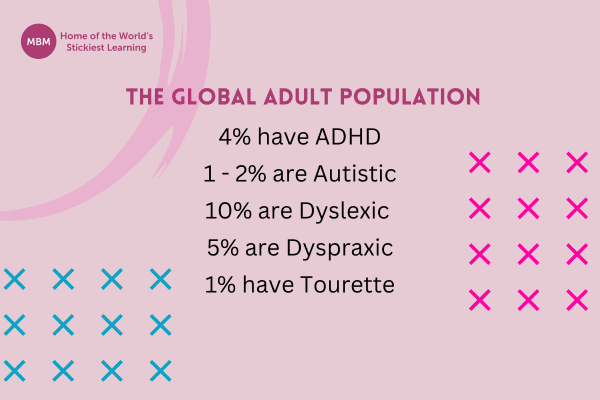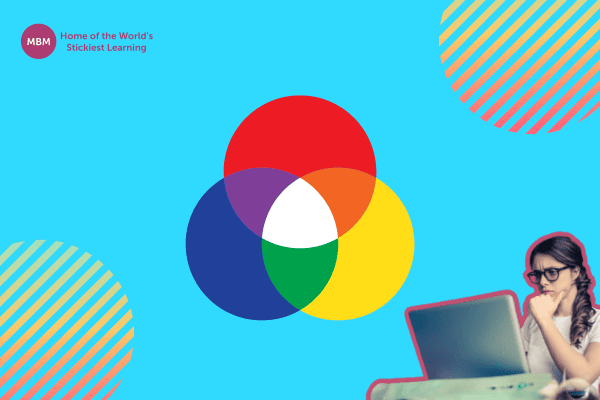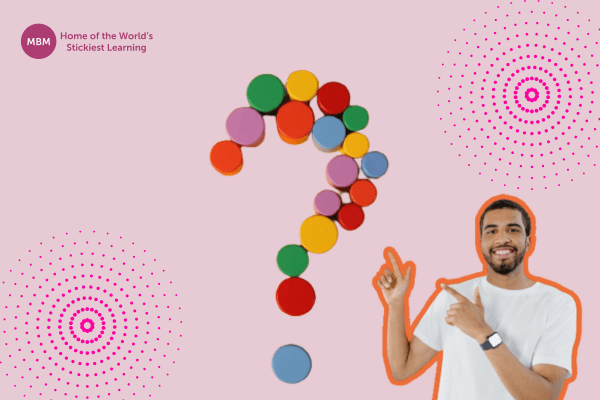From a Neurodiverse Perspective
Neurodiverse is not just a word, let alone a buzzword, for me. It is a lived experience and an integral part of my story. For as long as I remember, I have felt different.
Growing up, fitting in was impossible. So, at about ten years old, I remember deciding to mask. I started to carefully observe the behaviours of others, mainly popular kids and mimicked them to the best of my ability. This involved attempting to laugh at the right time or trying to look people in the eye. Surprisingly, for the most part, it worked.
I continued for decades and, slowly but surely, lost myself in the process. It took a major mental health breakdown that I now see as a breakthrough to start reconnecting with who I had buried deep within. Along this self-discovery journey, I began learning more about neurodiversity.
I would like to share with you some of what I have learned thus far. I will be mixing information with lived experience, and you will also hear from my neurodiverse inner voice in brackets (lucky you!).
Note that this is my view today. It will probably change over time, especially as the language continues to evolve in this space.

Before we get started, it is lovely to meet you all. My name is Solène. I am the Founder of Be Beyond Borders and a speaker, writer, and facilitator. As a multipotentialite, I find it very difficult to summarise my life and career. So, I will focus on the now. Currently, most of my work revolves around where neurodiversity and neuroinclusion meet innovation and culture.
What Does Neurodiverse Mean?
Firstly, Australian sociologist Judy Singer coined the term in the 1990s. Neurodiversity describes the fact that our brains and cognition all work differently. We are all uniquely wired. We think, feel, learn, and experience the world in a way that is ours and no one else’s.
Being neurodiverse is an undeniable and universal reality. In the words of Atif Choudhry, Co-founder of Diversity & Ability:
We are all neurodiverse, but not all of us are marginalised for it.”
Think of it as a bell curve with the illusion of ‘normal’ at the centre. We consider individuals who think, feel, and behave in a manner we perceive as close to the centre as ‘neurotypical.’ On the other hand, those who fall outside this range (hey, that’s me!) are marginalised and referred to as ‘neurodivergent.’ But divergent from what?
Taking it one step further, could this myth of normal be at the root of the neurodiverse umbrella and underpinning diagnosis we use now?
What Do We Commonly Find Under the Neurodiverse Umbrella?

Neurodiversity is an umbrella term, encompassing many different lived experiences. It can be innate, experienced from birth, or acquired later in life through an incident or event affecting the brain or cognition. Neurodiverse experiences commonly include, but are not limited to:
AD(H)D:
Attention Deficit Hyperactivity Disorder impacts concentration, attention, impulsivity, and emotion regulation (are you talking about me?!). In the global adult population, it is estimated that around 4% have ADHD.
Autism:
This refers to a neurological and developmental difference that influences how people interact, communicate, learn, and experience the world around them. In the global adult population, it is estimated that around 1 to 2% are autistic.
Dys-:
A set of brain processing and cognition differences that includes Dyslexia (reading, writing, memory), Dyscalculia (numbers, calculations, time), Dyspraxia (movement, coordination, balance), and Dysgraphia (handwriting). In the global adult population, it is estimated that around 10% are dyslexic and 5% are dyspraxic.
Tourette:
A condition of the nervous system that leads people to make involuntary and often sudden movements or sounds, commonly called tics. In the global adult population, it is estimated that around 1% have Tourette.

This is a non-exhaustive list and the debate around the crossover and boundaries between neurodiversity and mental health is ongoing. Should b.i.p.o.l.a.r., schizophrenia, and personality disorders be included under the neurodiverse umbrella?
There is a chicken and egg story here (brain starts clucking!)
Research reports a high correlation between neurodiversity and mental health challenges. A study by Willis Towers Watson (2022) shows that 70% of neurodiverse employees report higher levels of stress, anxiety, depression, and burnout. Could neurodiversity lead to mental health challenges due to the need to over-adapt to blend in? Do trauma responses and mental health challenges lead to neurodiversity in child development? Well, more research is required.
As someone diagnosed with ADHD and Borderline Personality Disorder (BPD), I would love to see both firmly included under the neurodiverse umbrella! If you have not heard about BPD before (please do not Google it, OMG! The stigma you will find out there…). BPD is a long-term mental health condition that impacts distress tolerance, sense of self, emotional regulation, and interpersonal relationships. So why do I wish to see it through a neurodiverse lens?
The neurodiversity movement has started to shift the narrative. It has given many of us a community and newfound pride in our cognitive identity. Unfortunately, many of the previously mentioned mental health diagnoses still lack this level of recognition, resulting in substantial masking, stigmatisation, and exclusion.

Read our return policy

>> Mental Health Coaching Cards <<
What is Masking?
Think of a chameleon changing its colours to blend in with the background. Similarly, masking refers to consciously or unconsciously altering our behaviour to conform and gain acceptance from our friends, families, communities, workplaces, and society as a whole.
Masking is common in the neurodiverse community. A study by Sedgewick et al. (2022) reports that 94% of autistic adults have masked at some point in their lives. It can feel safer and more effective (if you do not know the real me, it will not hurt as much when you leave). Over time, it might become second nature and seem easier than being authentic.
But masking comes at a significant cost to energy levels and mental health. It creates a cognitive dissonance that can lead to extreme emotional pain and, in some cases, panic attacks, self-harm, and suicidality.
This is where the difference between fitting in and belonging comes in. When we conform, we are embraced for the persona we pretend to be (which version of myself would you like to see today?). When we truly belong, we are accepted for who we genuinely are.
What Does the Inclusion of Neurodiverse Talent Entail?

Neuroinclusion is a call to action to welcome all brains and cognitions. Intentional neuroinclusive practices create spaces where we individually and collectively feel we belong. This comes with significant benefits. A Deloitte report (2018) shows that organisations with inclusive cultures are six times more likely to be innovative and agile.
Neuroinclusion means celebrating people as whole beings with their unique strengths and challenges. Could we stop using the word superpowers when referring to neurodiverse strengths, please? We’re humans, not machines or superheroes (have you seen my cape though?!).
We too have strengths and challenges. Let us recognise and welcome both. Leveraging neurodiverse strengths, such as creativity, empathy, problem-solving, and more, yields great results. In fact, the results of a programme conducted by Hewlett Packard Enterprise (2017), show that neurodiverse teams are 30% more productive.
Neuroinclusion entails providing opportunities to individuals with diverse wiring and ensuring that those opportunities are accessible and stimulating. For example, packing and being on time have always seemed incredibly difficult to me (to you too?). Meanwhile, public speaking is exhilarating, and I can create presentation slides at the speed of light until ridiculous-o’-clock (hyperfocus time!). So, like the innovation consultancy Othentik, ask me to do more of the latter and help me with the former (pretty please).
What Are the Common Barriers to Inclusion That Neurodiverse People Face?

Unfortunately, there are many barriers to neuroinclusion with dreadful consequences. Did you know that the unemployment rate for neurodiverse adults sits at about 30-40% versus around 5% for the overall population? In the UK, the unemployment rate among autistic people is nearly 80%, which is the highest rate compared to all other communities.

Identifying barriers allows us to provide support around them while we work to lower and ideally remove them. However obvious it might sound, this can be challenging to implement. Several neurodiverse traits are hidden or invisible. Also, many people are unaware of their own neurodiversity, while others self-identify as part of the community without a diagnosis (yet?). Consequently, many of the challenges and strengths within our community are frequently misunderstood or outright dismissed.
Here are a few examples of the numerous barriers we encounter while living in a world that is generally not constructed by and for us.
#1 – Educational Barriers:
Even today, there is a lack of understanding and education about what neurodiversity means. This leads to unhelpful stereotypes, stigmatisation, and exclusion.
#2 – Attitudinal Barriers:
From denial to dismissal or even discrimination, the neurodiverse community faces many challenges in education, the workplace, and society.
#3 – Physical Barriers:
Physical spaces can be very challenging to navigate. For some, bright lights and loud noises are triggering. For others, uncertainty and unclear objectives create profound stress.
Staring at this non-exhaustive list of barriers can feel discouraging. What if we instead saw it as an opportunity to rethink our approach?
How Can We Be Neuroinclusive?

Creating and fostering cultures where all neurodiverse people are welcome and can thrive is our responsibility, individually and collectively. It is not the work of the leadership team or HR alone. Being neuroinclusive is about creating safe spaces and environments where everyone can be themselves and show up how they wish to. Each one of us brings energy to every room, virtual or physical.
So, here are a few deliberate actions we can take to make every room a neuroinclusive one:
1 – Flexibility:
Flexible work arrangements can be life-changing, particularly for individuals with neurodiverse wiring who experience heightened productivity outside of regular working hours. Working from home, compressed hours, or a job share are all options worth exploring and offering.
Rethinking the way we evaluate people’s contributions is key to this. It is about time we reward performance rather than presence. This would mean shifting our focus towards goals and outcomes instead of whether people are in the office from exactly 9 am to 5 pm.
Making this happen requires trust, expectation setting, and open two-way communication. More importantly, though, it is about putting ourselves, human beings (and not human doings), at the core of our organisations and cultures.
2 – Anticipatory:
It is possible and essential to make reasonable adjustments in an anticipatory rather than reactionary manner. We must expect that there are or will be neurodiverse people in our spaces and make them inclusive and accessible by default.
Reasonable adjustments include providing access to assistive technology, curating the environment, and sending agenda, presentations, and questions in advance (yes please!).
Most adjustments are free. Asking the entire team to share their preferred ways of working normalises the conversation and benefits all. Tools such as access passports can be a great way to start a discussion around this.
3 – Curiosity:
Continually educating ourselves about neurodiversity and neurodiverse experiences is essential. Read, listen to, watch content and have conversations. Dr Stephen Shore famously says:
When you meet one person with Autism, you have only met one person with Autism”.
This is true across the board.
Think of identity as a giant puzzle made of multiple pieces. Our neurodiverse labels are one (or maybe a few) of those pieces. They are not the whole puzzle. What else do we carry? Our cultures, personalities, and preferences to name a few.
Hence why it is crucial to ask individuals about their own experiences and respect their preferred way to self-identify (ask me anything!). Some people prefer person-first language such as ‘person with a disability’, whereas others prefer identity-first language, for example ‘disabled person’. With that in mind, you should only call a person neurodiverse if they are comfortable and have agreed with you doing so (that’s cool with me!).
When in doubt, simply ask, while respecting whether the person is comfortable answering your questions at that time. How?
- Ask open-ended questions.
- Listen with the intent to understand.
- Refrain from making any judgments.
Neuroinclusion is a meaningful and powerful step forward. But it doesn’t stop there.
What About Going Above and Beyond for the Neurodiverse Community?
Neuroinclusion can be a challenging balancing act. Someone with ADHD (still here!) could be driving change full force, making it difficult for an autistic person who prefers consistency. Conflicts like this can occur in all teams, neurodiverse or not.
Creating a space where disagreements can happen in a safe and effective way for all team members is essential to building and fostering high-performing teams. I am talking about going beyond a culture of openness and acceptance, towards one where productive conflict can occur without any knock-on impact.
We tend to approach neuroinclusion from the perspective of equality, ensuring everyone has access to the same opportunities and support. But this is not sufficient. We must adopt an approach underpinned by equity, giving neurodiverse people the opportunities and support they need to level the playing field and reach an equal outcome.
Think about job interviews. Equality requires requesting everyone to come to the same place, at the same time, and with the same information. On the other hand, equity involves inquiring with neurodiverse candidates before the interview if they need any reasonable adjustments and ensuring their implementation.

>> Interview Questions Coaching Cards <<
Finally, We Must Consider Intersectionality
Coined by professor Kimberlé Crenshaw in 1989, intersectionality describes how different parts of our identities overlap, leading to unique experiences and layers of discrimination and marginalisation. Neurodiversity is not an exception. For instance, the diagnosis of neurodiversity is four times more common in men compared to women. This is due to gender bias in assessment design, measurement metrics, and in some clinicians.
In terms of race, a study conducted by Roman-Urrestarazu et al. (2021) revealed that Black boys in the UK receive diagnoses of Autism at rates comparable to their White peers, but they receive significantly less educational support after diagnosis. The lack of support is even greater for Black girls, alongside lower diagnostic rates. Neurodiversity also intersects with many other characteristics including age, LGBT+, socio-economic background, culture, and more.
There is a lot to do from neurodiversity to neuroinclusion and beyond. This is an exhilarating opportunity that will require and benefit from the innovative and creative ideas of all our neurodiverse, differently wired, brains (including BPD-ADHD me!).



